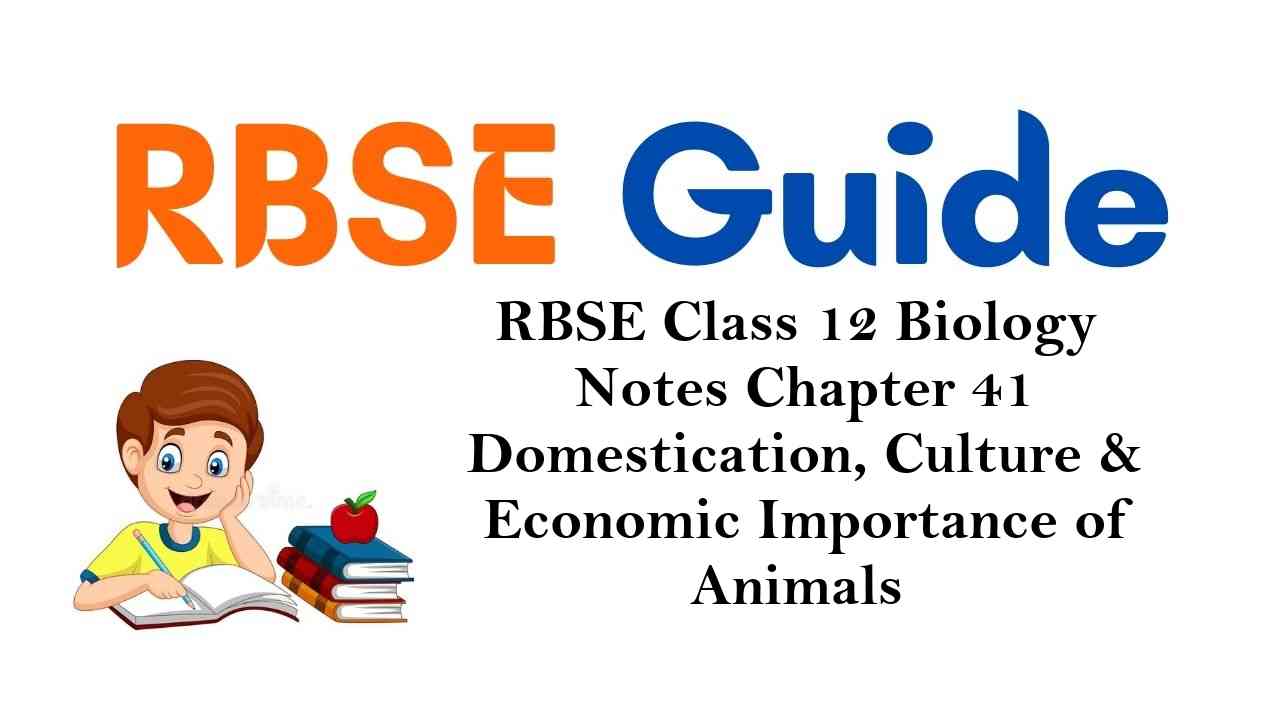Rajasthan Board RBSE Class 12 Biology Notes Chapter 41 Domestication, Culture & Economic Importance of Animals
- Importance of animal species for the human was realized and in view of that raising and breeding of animals for various purposes was done by man which is known as Domestication. In other words, rearing and management of animal species to get meat, milk, leather, fur, horns, wool, manure etc. is known as Domestication.
- Domestication of animals probably started since primitive human civilization. Hunting of animals and rearing or their domestication for human needs was started long back.
- Now a days, man has started the production of useful animals by scientific techniques. It is called culture. Some important animals of human use and their culture are briefly described here
![]()
Poultry Farming
general
- Fowl are in use by man since ancient time. In 20th century, the need of nutritive and tasty food has given a rank of significant cottage industry to poultry. Fowl (Hen) yields nutritional food in the form of eggs and meat.
- This Beneficial use of fowl attract human to search scientific technique for their reproduction, hatching, rearing and maintenance. For the success of poultry industry, knowledge of habits of fowl, breed and their reproduction is essential.
- For the country like India, which is heavily populated it is necessary to increase the use to get healthy & nutritious food.
- Some breeds of poultry are more suitable for meat production which are called Broilers e.g. Plymouth rock. Other breeds of hens have high quality hen gives 240 eggs per year and are called as Layers. While other normal hens gives only 60 eggs per year. Man has developed many species of hens for high quality egg and meat producing by artificial selection.
Bids useful in Poultry
Many species of birds are used in poultry. Some important species are given below:
Fowl (Hen):
In India domestic fowl, Gallus domesticus is the main species in poultry. Two types of fowl breeds are used for poultry viz.
(a) Indigenous or Desi Breed : These are Aseel, Kakamath, Brahma, Busara, Ghagus, Chittagong etc. Aseel variety is used in cock-fighting and it is reared like a game bird.
(b) Exotic Breeds : Mostly European hens are included as exotic birds. Important foreign breeds are White Leghorn, Plymouth rock, Rhode island red, New hampshire etc. These breeds are considered as super breed variety.
Ducks:
Duck,Anas platyrhynchos is also a source of eggs and meat. In India 6% poultry population is contributed by ducks. These are found in southern and eastern- states of India. Indian runner, Syhlet meta and Nageshwari are main Indian breeds, while foreign breeds are Muscori, Pekin, Campbell and Aylesbury.
Turkey:
Meleagris gallopavo (Meleagris) is domesticated in recent years. Some main breeds are British white, Narfold, Broad breasted bronze, Beltsville small-white etc.
Selection of fowls for breeding
Following points are to be considered in the selection of good quality hens for reproduction.
Selection of male fowl for reproduction:
Body of Cock must be shining, broad and strong. Eyes should be attractive, beak small and curved, wide back, skin thin and elastic, long tail with upward position.
Selection of female fowl for reproduction:
Size of hens should be large and in good shape. Good shape head and protruded eyes are the character of good quality of hens. Mature hens of below one year are to be selected. A hen of good health, fast growing, mature at an early age and producing more eggs are suitable for selection. The look looks active and always ready for defense of female. His roosting strine also be good. Such bird will produce healthy chicks.
Systems of Mating of Birds:
(a) Pen mating : Pen mating is a system in which one cock is kept with many hen i. e. one male for 10 females in captivity for mating.
(b) Flock mating : Many males in a flock of females. In such group fighting between male birds usually seen and the strongest cock will not- allow the weaker to mate. Hence this process may be allowed where no record of mating is required.
(c) Stud mating : Cock and hen kept in separate cages and as per requirement females are left with males for mating.
(d) Alternating males: In this mating, two cocks are used, one cock for one day and the other cock for the next day left for mating. There is difficulty in keeping record with this technique.
![]()
Systems of Breeding
Inbreeding:
It is mating between close relative of a species, for example between brother and sister, father and daughter, mother and son etc. This method of breeding is not preferred because the progeny becomes weak.
Line breeding:
Sometimes one bird is used for breeding again and again, because of its good quality. It is known as line breeding. In this type of breeding, close relatives are not allowed for cross between them.
Out Crossing:
It is a kind of mating, where birds of a species with different strains allowed for breeding. For example one species of white laghorn is capable to produce more eggs but of small size while other strain which is producing eggs of large size even in small numbers should be crossed.
Crossing:
Cross between different bird species is called hybrid, or hybrid vigour.
Grading:
Mating between pure male of a species with females of other species. Today’s poultry farming from commercial point of view hence hybrid species are mostly reared.
Incubation and Hatching
Incubation Period
The period between fertilization and hatching of embryo is called as incubation period.
Incubation period of eggs is different for each bird species e.g. hen 21 days, turkey 28 days, ducks 28 days and Japanese bater 17-18 days.
During incubation period, extra-embryonic membranes of developing embryo performs various biological activities such as, nutrition respiration, excretion and protection of embryo. Extra-embryonic membranes, never participate in the formation of organs of embryo.
![]()
Various stages of embryonic development
Before egg laying : Fertilization
Between egg laying and Incubation : No growth
During Incubation
- 16 Hours – First sign of chick embryo
- 20 Hours – Appearance of Vertebral Column :
- 22 Hours – Head formation starts
- 24 Hours – Eye formation starts
- 42 Hours – Heart beat starts
- 62 Hours – Leg formation Initiates
- 64 Hours – Feathers formation starts
- 5th Day – Formation of sex organs and sex differentiation begins
- 6th Day – Beak formation starts
- 17th Day – Beak turns towards air space.
- 19th Day – Entering of yolk sac into coelom
- 20th Day – Yolk sac enters into coelom completely
- 21st Day – Hatching of chick from the egg
Selection of eggs for hatching
Selection of eggs for incubation should be done carefully, because any type of abnormality in eggs cause adverse effect on hatchability.
Selection of eggs is done on the basis of shape, colour, quality of shell etc.
![]()
Artificial Incubation
Incubator is used for artificial incubation of eggs, which is essential for eggs to hatch out within 21 days. Eggs are kept for 18 days in a incubator and rest 3 days in other apparatus known as hatcher.
Benefits of Artificial Incubation :
Benefits of artificial incubation are given below :
- Many young ones can be produced at a time.
- Egg hatching can be performed as per requirement.
- Developing young can be protected from infectitious diseases.
- Expenditure is less in artificial hatching.
- Percentage of young one formation is more.
Brooding and Rearing:
Incubation of eggs is called Brooding and after egg hatching, the caring of young chick is called Rearing. Rearing can be done by two ways
Natural brooding:
Hen itself acts as a brooder and incubator. Generally a hen can brood 8-10 eggs at a time. It means hen incubate eggs by providing body heat.
Aritifical brooding:
The eggs are incubated artificially in a incubator and reared without hen is called artificial brooding. It has following advantage over natural brooding
- This can be performed in any month of the year.
- Chick can be reared in large numbers at a time.
- Cleanliness and management to save from diseases can be managed.
- Temperature can be controlled.
- Food to developing chick is given as their requirement.
- Hens are not required for brooding and rearing the young ones.
![]()
General
Before egg hatching it is essential to prepare a proper brooder house. Proper air flow, temperature regulation, safety from outer factors (animals), safety from storm, cold or heat waves etc. are required in brooder house. Large brooder house should be partitioned so that chicks of different ages can be kept separately.
Floor brooder:
Bomboos basket with clay on its both sides are prepared and it can be used as a good brooder floor for the development of chick. Wooden brooder, tin or aluminium brooder is also in practice.
Battery Brooder:
- In a small area maximum number of young ones can be reared upto 4 weeks after hatching in the battery brooder. However this method is not cheaper and hence not very common.
- In battery brooder there may be many tiers and such brooder also has a cold place where young can go if necessary.
- In Battery Brooder, bird with least age is kept at top floor. Water & food arrangement is outside and there is no mixing of faecal metter with it. There is less chances of infection/disease.
Poultry Farming using Cage system:
General
- Before this method came in practice, dip litter method was in practice. In this method, many hens cannot be reared togehter as each hen requires three square feet area and for large number of hen big house or poultry farm is required.
- In dip litter method, each hen require three square feet space. So instead of dip litter method, the cage method is more convenient and in use now a days because of increase in cost of hen houses.In dip litter method, each hen require three square feet space. So instead of dip litter method, the cage method is more convenient and in use now a days because of increase in cost of hen houses.
Benefits of Cage system
- More birds in small space : Less space is required as compared to dip litter method. If a one poultry house rearing one thousand birds and if cage system is followed than upto 2500 birds can be reared easily.
- Protection from diseases: Fowls are kept in the cages, hence any disease can not infect the whole group at a time. Hence, it is very useful.
- Scientist are of this opinion, that less food is consumed by hen in cage system.
- In cage system animal can be sorted out easily if required, while in dip litter system it is not so easy.
- Labour saving : It is believed that, less human labour is required in cage system, as one person can look after large hens.
Mangement Tips for Cage Layers:
Cage system requires different management than dip litter system. Some important points are as given below
- Food management : Food is to be supplied at proper time in cages. If food supply delays even by one hour, it will reduce the production. It is necessary to provide food three times a day (morning, afternoon & evening) one shall monitor food pipe for any problem.
- Water Management : Fresh water must be available at every time and the water pots and drainage should be cleaned properly and regularly?
- Fowl manure Management : The faecal matter accumulate in tire cage and develops foul odour. Hence regular timely cleanliness of cage is essential.
- Light Arrangement : Light muM be proper and every where in the cage so food can be’ ingested properly.
- Egg collection : Egg collection should be done atleast thrice in a day.
- Building construction : The building in cage system depends on our requirement. The height of the building depends on the layers of cages required. If two tier cages are required then roof must be at atleast 12 feet. If three tier cages are to be kept than 14 feet height of building is required. Flat roof is best. If hut roof is required then height should be 9-10 feet. Building should be made in dry area. Moisture of land will provide moisture to faecal matter, as a result Insects will increase in number & faecal matter will not dry.
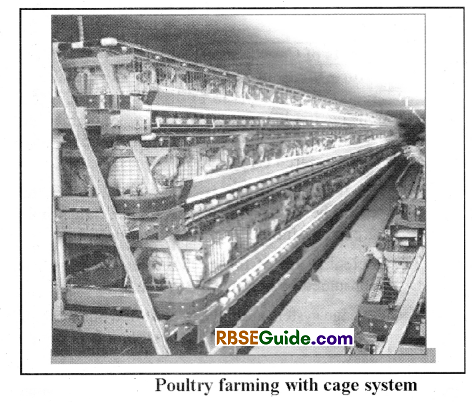
Poultry Food
General
Poultry food is prepared in view of following objectives
- To fulfill fowls nutritional requirements.
- For growth, development and reproduction.
- Provide energy for voluntary and involuntary functions.
- Non edible poultry food into edible food.
Different Poultry Feeds
(A) Carbohydrate Feeds:
It is 70-80% part of poultry food. Carbohydrate is used for energy, heat and fat production. It is cheaper in comparision to other food and easily available. Some of the important major sources are :
- Maize : It is maximally used in Poultry feed. It has starch and fat content in more amount.
- Wheat : It is just second to Maize. It contains less calcium but more amount of phosphorus. It also contains vitamin B & E. It can be used in many ways as poultry feed such as wheat fibres (Chapper).
- Oats : It contains 12% protein, 10.6% fibre and 4.7% fat. It can be given either as a whole or broken into smaller pieces.
- Barley : It can also be used in poultry feed just as oat.
- Sorghum : Its shape & structure is like maize but doesnot contain vitamin A. It is beneficial only when its cost is lower than wheat, maize or oats.
- Rice : It is also used inplace of other cereals but its price normally remain higher than other cereals so used very less.
- Molasses : It is remaining part after sugar is formed from sugarcane juice. It can be used as 5-10% replacement of cereals.
- Potatoes : Those potatoes which cannot be consumed by human being small in size, can be boiled and given to hen.
(B) Fat Feeds:
Fat is main source of energy. It is mixed in feed upto 2 – 5%. Fat improve the size of fowl, it increase hunger so more food is consumed resulted into well physical development and increase egg production. Fat is obtained from these substances
- Soyabean oil
- Ground Nuts oil
- Cotton sead oil
- Maize oil
- Wheat germ oil
- Animals fat
- Emulsified oils.
![]()
(C) Protein feeds:
It is most important part of nutrition. It is basic requirement for physical development and egg production. Protein feed is obtained from
- Animal protein feed : It includes milk, meat scrap, fish meal etc. It has more mineral elements and vitamins.
- Vegetable protein feed : Important vegetable feed is soyabean meal, comglutenmeal, oil cakes of groundnut, cotton seed and sunflower oil.
- Milk : It is best source of protein but it is costly so not in practice.
- Meat scrap : In chicken food it is used to obtain protein and minerals.
- Feather meal : It has 86-88% protein, but essential amino acids are not found in it. 10-20% of protein part can be used in poultry feed.
- Poultry blood meal : It has 65% protein, it can be used only upto a small part of total protein requirement.
- Soyabean oil meal : It is significantly used in soyabean producing area. Soyabean is a very rich source of protein. In India Groundnut oil cakes are mostly used, now these days soyabean cakes are also in use.
(D) Mineral Meals
- Calcium : Calcium carbonate is best source of it. It is obtained from oyster shells, marble chips and’egg shells.
- Phosphorus : Tricalcium phosphate is chief substance in bone meal. It is given to get phosphorous.
- Manganese : It’s requirement is 50 parts per million but it is essential for hatching and bone formation.
- Salt : Salt is essential for taste and digestion.0. 5% of Salt. In the similar way Iron, Iodine is also added in Poultry feed is added in food.
Common diseases of Poultry
Some poultry diseases are as follows:
Viral diseases:
The main viral diseases in poultry birds are Fowl pox. Infectious bronchitis, Lymphoid leukosis and Ranikhet disease. The most common disease of fowl is Ranikhet in which fever, diarrhoea occurs.
Bacterial diseases:
These diseases are Fowl cholera, Pullorum, Coryza, Mycoplasmosis and Spirochaetosis.
Fungal diseases:
Afltoxicosis, Brooder pnemonia and Aspergillosis are main fungal diseases.
Fish Culture or Pisciculture or Fisheries
General
- In developing countries like India, Supply of milk and meat per person is very less. Hence, fish supplement is essential in the diet of such countries.
- The necessity of fish protein in the country is approximately one crore tonns per year, while we have only 35 lakh tonnes production of fish annually. Fish culture provide income and employment to the people residing in costal states of the country.
- Various techniques are used to increase production of fish to full-fill the demand.
- Fish production in India has approximately 2.34% area of inland water, which is approximately 75 lakh hectare.
- As a result of reasearches conducted at Central Inland Fisheries Research Institute, the fish culture and production increases upto 85000 kg./hectare/year. It is a revolution in the field of fisheries.
- Fisheries or fish culture gained much importance in order to encourage the young men to take up small scale industries as a carrier.
- Pisciculture or fish culture involves production and breeding of fishes.
- Fishes are the best source of protein. Besides proteins, it has mineral salts, Vitamins (Vit-Aand Vit-D) and healthy fats in sufficient amount. Fish is a complete food for men. Some fishes e.g. Common carp, Catla, Rohu (fresh water fishes) and Hilsa, Sardine and Prophrate (marine fishes) are edible.
- Because of high consumption, these fishes are cultured by scientific techniques.
- Along with the fishes other aquatic animals e.g. Prawns, Lobsters, Molluscs etc. are also cultured and it is considered as aquaculture.
Types of Cultivable Fishes
Cultivable fishes are of three types
- Indigenous or naturally occuring fresh water fishes.
Example – Major carps. - Some marine fishes which get adapted to fresh water
Example – Chanos, Mullets etc. - Exotic fishes- Those fishes which brought from foreign countries in India
Examples – Mirror Carp, Chinese carp, Crucian carp and Common carp.
Management of Fish Culture Programme
Breeding Pond
- For reproduction of fish, special type of ponds are constructed, which are known as Breeding Ponds. Such ponds are constructed near river or source of water.
- The shape and size of pond may slightly vary with respect to species of fish. Some times different stages of fish development can be cultured in ponds of different characteristics. Looking into different stages of fish development, different ponds are made for their culture.
- Management of ponds is of much significance which includes fish Hatching, Nursing, Rearing, Stocking ponds.
Types of Breeding
Fish breeding is of two kinds-
- Natural breeding
- Induced breeding
![]()
Natural breeding or Bundh breeding
Natural bundhs are of special kind of ponds, where natural riverian conditions or any natural water source is used for reproduction of culturable fishes. Such specially designed ponds are made in lower areas. In such ponds huge amount of water is stored and extra water can be extruded out from the pond. Shallow area of pond is used for spawning. Bundhs are of three kinds
Wetbundh:
In such ponds water is available throughout the year.
Dry bundh:
Water remain only in rainy season in these ponds, afterwards such ponds become dry.
Modern bundh:
These are also called “Pakka bandh”. Walls of these ponds are constructed with bricks and cement. Lowest part of such ponds have outlet, which it is specific character of pond. Exit gate is used to take away all water after spawning has occurred.
Induced Breeding
General
- For this purppse fish seeds are required which are collected from the places of fish reproduction. But some lacuna in this process is that the eggs collected may contain eggs of predatory fish also. Hence, certain developed techniques are used to get quality fish seeds.
- For artificial fertilization, a female fish full of eggs in her body is taken & pressed from upward to downward and eggs are collected carefully. Similary, mature male fish of same species is also taken and semen is collected by pressing abdomen from below side.
Fish Seed
Many stations for fish collection are established at Ganga, Yamuna, Brahmputra rivers. Fish seeds are collected from breeding places of Ganga, Yamuna, Gomti, Betwa, Gagra and other rivers.
The best places to collect fish seeds from these rivers are turns in the way of river. The net for spawn (Freely laid eggs) of collections is normally a Shooting net or Benchi jal- These are transfer to hatching pit after collection.
Hatching pit
They are rectangular trough size tanks called happas. In these happa fish eggs get air through running water. Such happas are fixed by bamboos in river in which ‘mosquito net type cloth’ is tied.
Size of happa is 3′ x 1.5’ x T. In the happa, fish fry come out from eggs and then transfer to pond.
Following things should be kept into mind before making hatching pit
- Hatching pit should be near reproductive site.
- It should be small in size.
- It should have so much amount of water which can dry in a month or two.
- They should be more in number.
Types of Hatching Pits
- Hatcharics : This is small size pond where fertilised eggs are transferred. Within 2 to 15 hours, the eggs hatche out to form new ones.
- Hatching Hapas : These are rectangular shape trough. Due to continuous flow of water in this happa, the egg of fishes gets fresh supply of air. It is being prepared by putting thick cloth in between Bamboo Mosquito net is being used invide this happa. size of this happa is about 3′ x 1.5′ x 1′.
Fish fry are collected and transferred to culture pond. There is chance of death of fish fry while transferring.
To carry fish fry from hatching hapas to nursing pond is done through Alcathen bags.
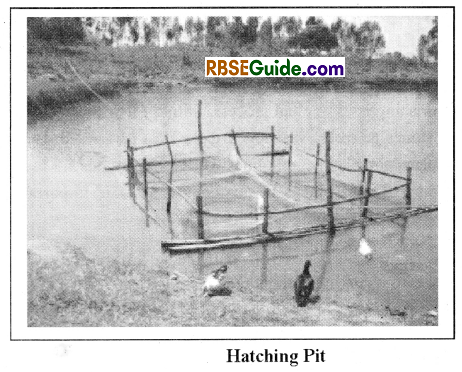
Nursing Pond:
Nursing pond should be prepared well in advance before hatching of fish-fry. Entry and exit of water should be controlled. Predator fish should not be there in nursing pond and natural or chemical fertilisers should be used which help is growth of “Plankton” which act as food of fish. Death rate increases in nursing pond so extra precautions should be taken. When “fish fry” becomes 10-15 cm in length then it is tranferred to Rearing pond.
Rearing Pond:
- Fingerlings can get complete nutrition is rearing pond because these are big ponds and doesn’t have predatory organisms and proper arrangement is done for proper growth & heatlh of fingerlings. They may be seasonal or annual. When their size becomes 20 cm in length, they are transferred to stocking pond.
- Container of 1000 litre capacity are used to transfer these fingerlings. Such containers are lined with foam by which fishes protect from shocks and proper aeration is kept for oxygen supply.
Stocking:
- Sufficient food supply is essential in the water bodies for better growth of the fishes. Simultaneously entry of predator fishes must be checked. Manure must be sufficient in water bodies for the development of plankton.
- All depends on the number and species of fish.
- Full developed fishes are captured for sale and small
- fishes are left in nutrition tank or stocking tank for further growth.
![]()
Methods of Fishing or Harvesting
Catching of fishes from the water bodies is called as Fishing.
Fishing is an ancient process. Initially it was caught by stones or spears but now a days, it is performed using nets, complex net and lines. Different methods are used at different places in our country. Some important methods of fishing are following
- Standing fishing
- Angling fishing
- Trap fishing
- Fishing by Scooping
- Dip or Lift Net Fishing
- Fishing by Ghagaria Jal or Cast Net
- Fishing by Gill Net
- Fishing by Drag Net
- Fishing by Purse Net
- Electric Fishing
Fish Preservation
Fishes caught by fishing are preserved. Preserv ation prevents decomposition and spoilage of the fishes. Following methods are used for fish preservation
- Refrigeration
- Deep Freezing
- Drying after Freezing
- Sun drying
- Sun Curing
- Mona Curing
- Wet Curing
- Salting
- Smoking
- Canning
Preserved and canned fishes can be transported to distant places & can be stored for long time.
Apiculture or Bee keeping
General
Honey bee is a member of class Insecta of phylum Arthropoda. It is a social insect which shows polymorphism and division of labour. The modern scientific and commercial method of breeding and caring of bees for the production of honey and bees wax is known as Apiculture.
Although knowledge of apiculture exists approximately before 4000 years, but the scientific method for apiculture was developed before few decades only. Following points are significant for apiculture
- Knowledge of habit and habitat of honey bees.
- To catch swarm of honeybee & keeping them in hives.
- Management of hives in different seasons, maintenance & collection of honey and wax.
Important Species of Honey bee
Four species of honey bees (Apis) commonly found in India. These are :
- Apis dorsata or Rock-bee : It is the largest honey bee and popularly known as Giant Honey bee. It yields maximum honey. Due to their ferocious, irritable nature and migratory habits they could not be domesticated.
- Apis indica or Indian Mona-bee : The small Indian bee inhabits forests and plain areas of India. It is of gentle nature so easily domesticated. The yield of honey is less i.e. 3 to 4 kg per comb.
- Apisflorea or Bhringa bee : It is still smaller bee and honey yielding capacity is only 250 gms. per comb. It is not useful for commercial purpose.
- Apis mellifera : It is also known as European bee which is docile in nature and easy to domesticate. It yields 27-30 kgs. honey pei comb and it is the best for commercial purpose. Its Italian variety is most important.
Social organisation of Honey bee
- A colony of honey bee shows of high grade social organisation and division of labour.
- Colony of honey bees consists of three kinds of individuals or Castes
Queen
In the whole colony, there is only one adult queen of large size. The queen arises from a fertilized egg and when larva especially fed on royal jelly. It is only fertile female in the beehive, having huge developed ovaries. Function of queen is only of reproduction i.e it lays eggs
Drones
Drones developed from Unfertilized eggs i.e. parthenogenetically. The function of drones is only to mate with queen fertilize the eggs.
Workers
They are sterile females whcih develop from unfertilized eggs. Their number varies from 3000 to 6000 or more.
![]()
The worker bees are of three types :
(A) Sanitary bees:
These bees clean the chambers of the hive.
(B) Nurse bees:
These workers look after the queen & hive.
On the basis of ages they are of 3 types:
(i) Foster mother:
- They are the nurse workers of 4 to 6 days.
- They feed mixture of honey & nector to the infants.
(ii) The nurse workers of 7 to 11 days
They secrete royal jelly which is secreted by niaxilary glands.
(iii) Nurse workers of 12 to 15 days
- They secrete wax from the wax glands during this period of 4 days. This wax is used to repair & reconstruct hive.
- The wax glands get functional up to 12th day. They secrete propolis which is a gumlike substance.
These nurse workers are of 4 types
- Fanning bees – They fly stationary near the nest to maintain air flow.
- Sentinel bees – They act as guard of the nest.
- Soldier bees – They protect the hive intruders. They also check the honey collected by the bees.
- Retinue bees – They clean the queen & queen chambers. They also feed royal jelly to the queen & transfer eggs to other chambers.
(C) Scout bees
They are also called as field or foragins bees
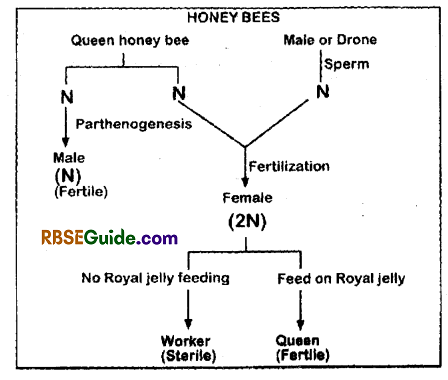
They search new food sources & collect nector & pollens.
They collect food 7 to 15 times a day.
They also collect water. The water requirement of a hive is to 2 litre per day.
![]()
Methods of Apiculture
There are two methods of apiculture :
- Old Indigenous method
- Modem Scientific method.
Old Indigenous methods
- This method is very crude and in use since ancient time. In this method, the bees are first killed or made to escape by smoking or by bringing fire near the bee-hives during night.
- The main drawback of this method is the honey thus extracted is not pure because the eggs, larvae and pollen cells are also extracted. It destroy the old colony and hives. Bees may not construct new’ hives at the same place.
Modern Scientific method
In modem method, honey bees are reared in movable artificial hives. Honey is pure and no harm to hives. This has converted apiculture into a cottage industry providing employment to lakhs of village and urban people.
Appliances of Apiculture
Following appliances are used in modem method :
Artificial bee hive
- It was discovered by Langstroth, 1851. It is a wooden boxe which can be shifted easily.
- The wooden box is made up of tw o chambers. The larger low er chamber is called brood chamber, which contains the queen bee.
- The upper smaller one is the super chamber. Both chambers are separated by a perforated zinc sheet known as Queen Excluder.
- Pores of the perforation sheet are so small i.e. 3.75 mm so that workers and drones can pass easily through them but queen cannot enter in upper chamber.
- The entire Bee-hive is mounted on a stand which is adjustable for creating slope of the hive.
Comb foundation : The brood chamber contains 5-10 vertical frames in parallel positions. Each frame has bee wax sheet vertically with hexagonal chambers on both sides. These wax sheets are called Comb foundations. Such comb foundations are also kept in Super chamber, in which honey is collected by bees.
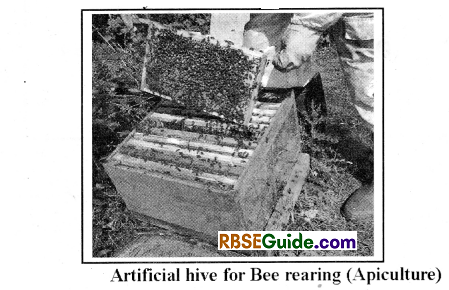
Honey Extractor
Extraction of honey from artificial hive is done using honey extracting apparatus or honey Extractor. It is a large drum of tin having revolving rods bearing pockets of netted cloth [Fig. 41.4]. One tap at the bottom of drum.
Honey is extracted on the Principle of centrifugal force. The pure honey extracted is collected through a basal outlet. The comb foundation remain unchanged and can be used again and again.
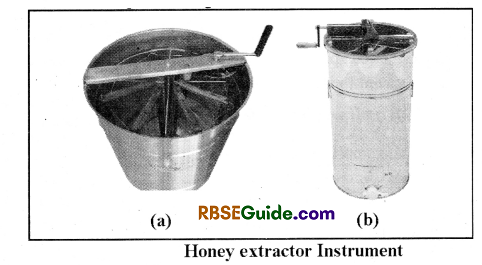
Uncapping knife:
Honey part of hive, has chambers full of honey which are sealed with wax by the worker bees. Before placing these combs in honey extractor, their wax seals are to be uncapped by touching heated knife on the caps.
Miscellaneous:
- A smoking apparatus is a tin box with an outlet at its top for the smoke to come out. This smoke controls honey bees when smoke is released from the smoking apparatus.
- The persons working for honey collection wear rubber hand gloves to protect hands from the sting of bees.
- The whole body is also covered with bee net made of silk or cotten cloth to protect from the attacks of honey bees.
Precautions:
Following precautions are necessary for honey bee culture or Apiculture :
- Plants of fruits and flowers should be with in one kilometer only from the hives.
- Artificial bee hives should be kept in cool & shady area.
- Source of fresh water must be in the nearest vicinity.
Advantage of Modem method
There are many advantages to culture bees with modem methods. These are :
- Activities of honey bees is under the supervision of man.
- By providing artificial food, development of a colony is possible.
- A single hive can be used again and again and honey workers are more concentrated to collect honey only.
- In adverse season the hives can be shifted to safer place.
- Bee-hives can be protected from enemies.
Economic Importance of Honey bees
(i) Honey bees help in pollination
(ii) Honey
- Honey bees yield honey. A normal hive (150 gm empty weight) yields about 4 kg honey. Honey bees collect nector for 1.5 lakh times to form 1 kg honey.
- Honey is the stored form of food. It is acidic in nature. It acts as a tonic & antiseptic.
- Honey consists of many enzymes, organic salts, vitamins & organic acids (Mallic acid, Tarteric acid, citric acid etc) in addition to glucose & fructose.
- Honey is also used to clean eyes.
(iii) Bees Wax
- It is used to form hive.
- The wax is a white-yellow coloured substance which is secreted by the wax glands of worker bees.
- Wax is also used in cosmatic products, medicine ointments, paint, polish etc.
(iv) Bees Venum
- It is an acid which is also called as epitoxin
- This toxin exhibits anit-biotic properties.
- This toxin strengthen body immune system.
![]()
Search of food & communication
- Honey bees search food with the help of scent & sight.
- They have good power of navigation.
- In navigation, they use direction of sun, environmental directions, scent of flowers, land marks etc.
- When the scout bees search new source of food, they return to the hive & inform bees workers which meant to collect food. The information is given with the help of specific movements which are called as bees dance.
- Bees dance was first explained by Karl Von Frisch. He was awarded Nobel prize for this discovery.
The bees dance is of two types
(i) Round dance:
- It is exhibited when the food source is within 75 meter.
- The bee takes round circles.
(ii) Tail-wagging dance:
- It is exhibited when food source is beyond 75 meter.
- It also indicates the direction of food source.
- The bee produces low sound during dance by vibrating wings.
- In this dance, the bee first moves straight than after moving along a semi-circular path on one side, it again moves straight.
- Now, it again moves along a semicircular path but on the second side and again moves straight. During moving on straight line, the scout bee moves its abdomen side ways.
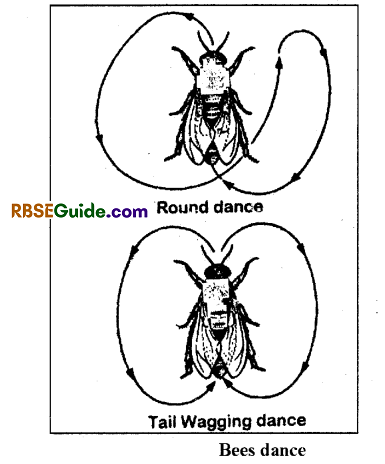
Sericulture
General
- Production of silk at commercial level and the rearing of silkworms is called as Sericulture.
- Firstly in 2697 B.C. in K Wang Ti state of China’s, princess Lotzu discovered production of silk. In India it was first done by Lefroy, 1905 at Pusa Institute, New Delhi.
- Indian silk is known globally for its lustrous shining and its traditional colour coordination.
- Assam, West Bengal, Tamilnadu. Punjab, Kashmir are major silk producing states in India.
Major Species of Silkworm:
Major species of silk worm and types of silk they produce and, leaves of the plant which they feed are listed in Table .
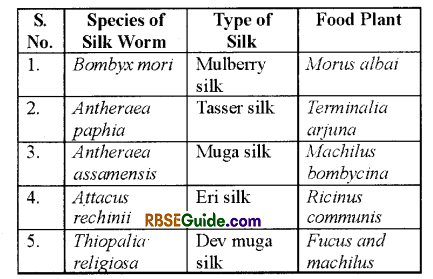
Out of the species appended in this table, Bombox mori .
is the most important. It is reared on Mulberry leaves. It is also known as Mulberry Silk moth. It belongs to the family Bombycidae.
![]()
Life cycle of Mulberry Silk Moth
- Adult moth is of 4- 5 cm in length and creamy white in 5. colour. In life cycle egg, larva, pupa and adult moth stages are found. Fertilization is Internal. Egg stage in normal phase for 10 days and the larva stage is continued for 30¬35 days. Larva of moth is called Caterpillar.
- Larval stage is the most important and active phase of its life cycle. In silk worm’s larva five Instar phases are found and it shows 4 time moulting.
- The caterpillar is cylindric, smooth and 4-5 cm in length. It has a pair of silk glands which are modified salivary glands.
- The larva feeds actively on the leaves of Mulbury. The silk glands secrete a thread which called as silk thread. The larva wrap the thread around the body to form a covering or pupal case. This stage is called as cocoon.
- The larva forms pupa called chrysalis inside the cocoon. .After 10-12 days, the pupa comes out of the cocoon.
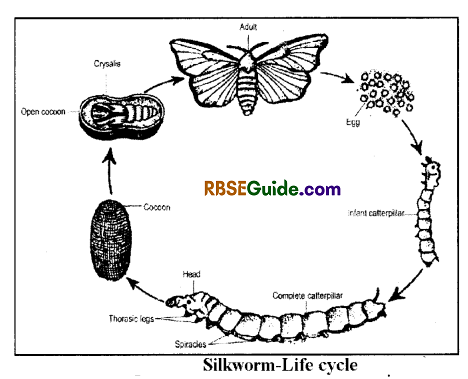
Sericulture Industry
- Production of silk and the rearing of silkworms at commercial level is called Sericulture.
- Silk is a natural animal product.
- The sericulture is a complex process and industries good quality plants of Mulberry and developed species of Bombox mori are needed.
The additional requirements are as follows :
- Machana- Suitable place to culture silkworm
- Rearing tray- To keep silk worm eggs with mulberry leaves
- Spinning Tray- To keep caterpillar which are going to be conv erted in pupa.
- Dalas- To bring mulberry leaves
- Chopping Knife- To cut the mulberry leaves into small pieces
- Basket- To distribute mulbery leaves.
- Hygrometer- To measure percentage of moisture
- Thermometer- To measure temperature of room
- Oven- To keep some stages of silkworm at controlled temperature.
- Freezer – To keep store eggs and seed for next generations.
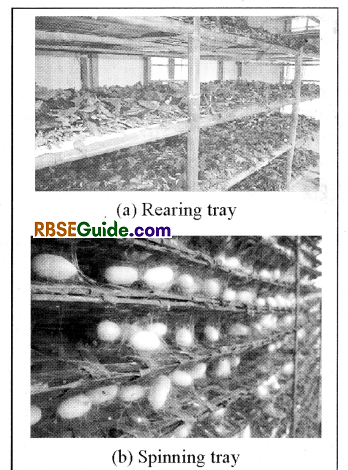
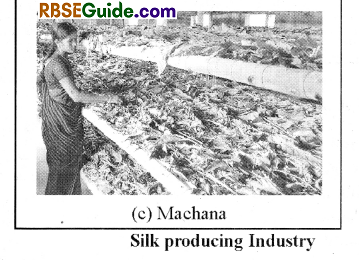
Rearing of Silkworm
General
Silkworm rearing is an extensive month-long exercise starting from egg stage, aestivation, hibernation, incubation and finally cocoon formation. For maintaining systemic culture. Grain age technology is important.
Grainage Management
- The most important stage of sericulture, is the producti on of healthy and disease-free eggs and egg management and it plays a vital role on which the success of the industry depends. There are the main objectives of Grainage Management.
- This managements keeps caterpillars with healthy nutrients, disease free etc. cocoons are developed from caterpillars.
- Alter last selection, coccons are separated by their sex. This is performed using Naghara instrument. This machine cut 10,000 to 15,000 cocoons. For industrial puipose of egg production, loose types of cocoons are used. Mass pebrine detecting machine or simple microscope is used for detection of female adult silkworm and pabrin disease free worm.
Supply of seed to rearers and commercial rearing
After grainage management, second step is to supply eggs to cultivators. On the basis of the knowledge and experience of cultivators it is of 2 types
(i) Supply of eggs
(ii) Supply of Instar Caterpillar.
Those who have a experience to culture silkworm, take eggs but those having no experience always take 2 stage instar caterpillar. I, II, and HI stages of Caterpillar are carefully handled. IV and V stage instar caterpillar are provided nutrients through nylon net plate.
From this technique, high quality of cocoons has been made. To culture 1,2,3,4,and 5 instar caterpillar temperature should be 27°C, 27°C, 25°C, 24°C & 23°C maintained respectively.
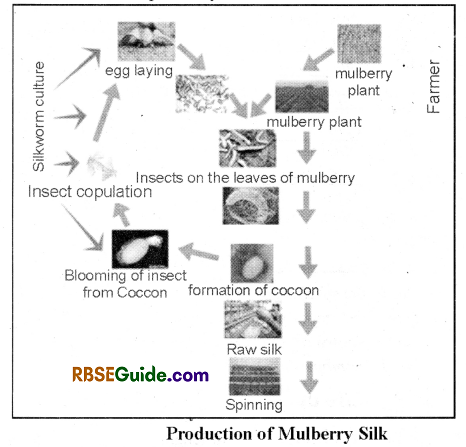
Formation of Cocoon
This is the time when caterpillar stop taking food and it secretes sticky substance. In this phase caterpillars are transferred into spinning tray. These trays are kept sideways in sun. After 3 days cocoons are formed which is the last stage of sericulture.
Method of obtaining silk from Cocoons
- Firstly, cocoons are kept into hot oven or hot water to destroy cocoons shell. This process is called Stiffiling.
- Afterwards, cocoon are reeled together to produce a single thread. One cocoon makes 1000 to 15000 meter long thread.
- This thread is rolled on spool (Reded silk) and again it is boiled in hot water. It was washed with chemical acids which make it clean and shiny.
- They are changed into Fiber silk when spined. This process is called spinning.
Diseases of Silk Worm
Silk worm can have many diseases. Main two diseases are as follows :
It is of two types-
(A) Virus Pebrine
It is caused by Borreline bombycis virus. After 8-10 days, larvae start dying. For protection dead larvae should be separated and instruments are rinsed with 30% solution of Trichloro acetic acid for 15 minutes & then washed with water.
(B) Protozoan Pebrine
It is caused by Nosema bombycis protozoa. It affects both the larva and adult. The adult shape gets irregular, shrink and larva get small in size. Death of larvae before formation of cocoons. For protection, only eggs from healthy worms should be used.
![]()
Flecherie and Grasserie – These diseases are caused by viruses.
Types of Silk
The silk is of 5 types :
(i) Mulberry silk:
- It is the most common silk.
- It is produced by Bombyx muri which is a domestic animal.
- It is the best silk which is white-yellow in colour.
- It feeds on mulberry leaves.
- It is produced in many countries.
(ii) Tussore silk:
- It is produced by Antheraea paphia.
- It feeds the leaves of sal, ber, oak, gullar etc.
- It is a wild species which is common in China, India & Srilanka.
(iii) Muga silk:
- It is produced by Antheraea assama.
- It is a semi-domestic animal which is reared on leaves of Dal chini & machilis.
(iv) Eri silk:
- It is produced by Antheraea recini & Atacus alias.
- It is also called as arendy silk.
- It is cultivated on caster plant.
(v) Oak silk:
- It is produced by Antheraeapernyi, Anthereae roylei & Anthereae yamamai.
- It is a good quality silk.
- It is found in Japan & China.
- It is reared on oak plant.
Lac Culture
- Lac is the scarlet resinous secretion which is secreted by lac glands of Lac insects.
- Mass rearing of Lac insects is called as Lac culture.
- First scientifically description was given by J.Kerr in 1782. He gives its name Coccus lacca. In 1812, Oken gives its genus name Laccifer and it is also known as Laccifer lacca.
- In 1913, Mehandi Hasan gives its name Lashadia indica but A.B. Mishra (1930) gives Lacifer indica and again it it was changed by A.P.Kapoor (1658) and named Lacca indicola. Finally due to Glover suggestion it was again named as Laccifer lacca. During from last few years its names was kept Kerria lacca from it discover name shri ker. However it famous name still is laciffer lacca.
- India produces 80% of lac from total production in world. India export 90% of its production to many countries. Apart from India Thailand, China, Pakistan, Nepal, Sri lanka, are the major producing countries.
- In India Assam, Bengal, Bihar Rajasthan, Uttar Pradesh, are the major producing states of India where Lac insects are reared & lac is produces.
Salient features of Lac Insects
- In lac insect, males & females are separate i.e. it shows sexual polymorphism. Male length is 1.2-1.5 mm and red in colour. Theyare small is comparison to female.
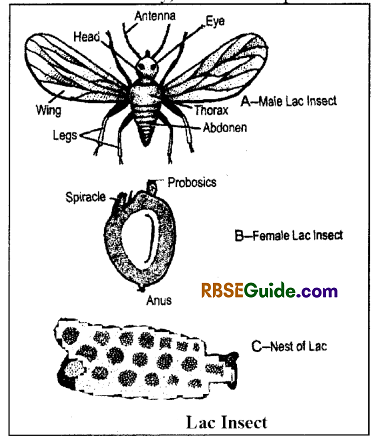
Female has soft body and oval in shape. Females are big and 5 mm in length. The body is indistinctly divided into head, thorax and abdomen. It is dark red in colour and does not have wings. Female lives in resinous sac. - Female gives 200-500 eggs in resinous sac. After 6 week first Instar larva comes out. It is called Nymph. They are active and accumulate at the small soft twig of succulent tree.
- They secrets lac from their skin gland Nymph which gets dry when come in the contact with air. Present on skin take sap as a nutrient from succulent plants. After 6 to 8 weeks due to metamorphosis nymph change into 70% wingless females and 30 % males with wings.
- In every year 2 times they complete their life cycle (Oct-Nov and June-July). On nutritous plant.
Host Plants for Lac Insect
In India there are many plants on which lac insects complete their life cycle. Some of the plants are follows
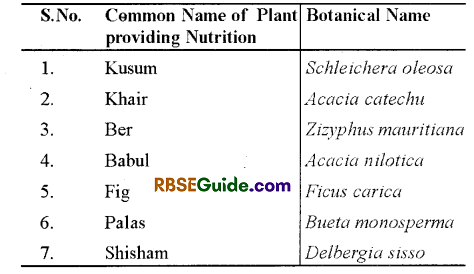
Lac insect sucks sap using its appendages. Quality of Lac depends on the type of plants. Kusumic lac is best lac which is obtained from Ber & Palas plants.
Cultivation of Lac:
It is a complex process. Farmer should have complete knowledge of inoculation, swarming and collection.
Inoculation:
Inoculation is the first stage of lac cultivation. It is the process by which newly hatched (brood) nymphs get associated (settle) with new branches of host. This is of two types-
(A) Natural Inoculation
It occurs naturally in nature. In this process of inoculation, the swarmed nymphs of one plant infect the same host again and start to inhabit (encrust) on it and starts sulking juice from branches.
(B) Artifical Inoculation
In this, cutting and harvesting is done in the month of January and June. Seed twigs are cut in length of 20-30 cm where nymphs lived. Then these cut pieces are tied to fresh succulent twigs of the host plant in such a way that each brood twig gets touched at several places through which migration of nymphs from brood twig to host twig can take place.
![]()
Swarming:
It is most important stage of lac cultivation. The nymphs swarm from brood and migrate to tender and succulent twigs of host plant to infest them. Following swarming of nymphs, the hollow cavities left in the cell get covered with lac (a resin).
Harvesting:
Harvesting is the process of collection of lac from the host trees. It is done by cutting the lac encrusted twigs when it is matured.
Arilac in April -May, Kataki in October -November, Ahagani in January’ February and Jethavi and Basakhi in June and July are harvested.
Scrapping of Brood lac:
The scraping of lac from twig is done by knife, after which they should not be exposed to sun. The scraped lac is grinded in hard stone mills. The unnecessary materials are sorted out. Probable mature date of maturing of crop can be anticipated from following changes
- Appearance of cracks in lac before 15-20 days
- Body fluid of female gets thick.
- Eggs gets separate from egg group.
- Eggs feel like granular
- Outer color of lac gets yellow and becomes dry
Washing of Lac
- Scrapping lac is called Stick lac. This sticky lac is washed with water. Lac dye is the colour which comes out from washing which is dried under shade. India produces 2 crores kilogram of lac every year, which is of 60% of total production worldwide.
- In India, out of total production, 50% is produced in Chota Nagpur located in Bihar.
- It is used to make bangles, polish, utensils formation, toys, varnish, electricity instruments etc. For the production of high quality of lac, Indian Institute of Natural Resins and Gums, Namkum, Ranchi has made significant contribution.
Types of Lac
Lac has many varieties which is as follows :
- Ari lac- It is a immature lac harvested from host plants
- Stick lac- It is a mature lac harvested in the form of stick from host plants
- Seed lac- It is obtained after removing & washing of stick lac
- Dust lac- It is obtained after grinding of seed lac
- Shell-lac- It is prepared after heating seed lac and dust lac and formed as plate like structure.
